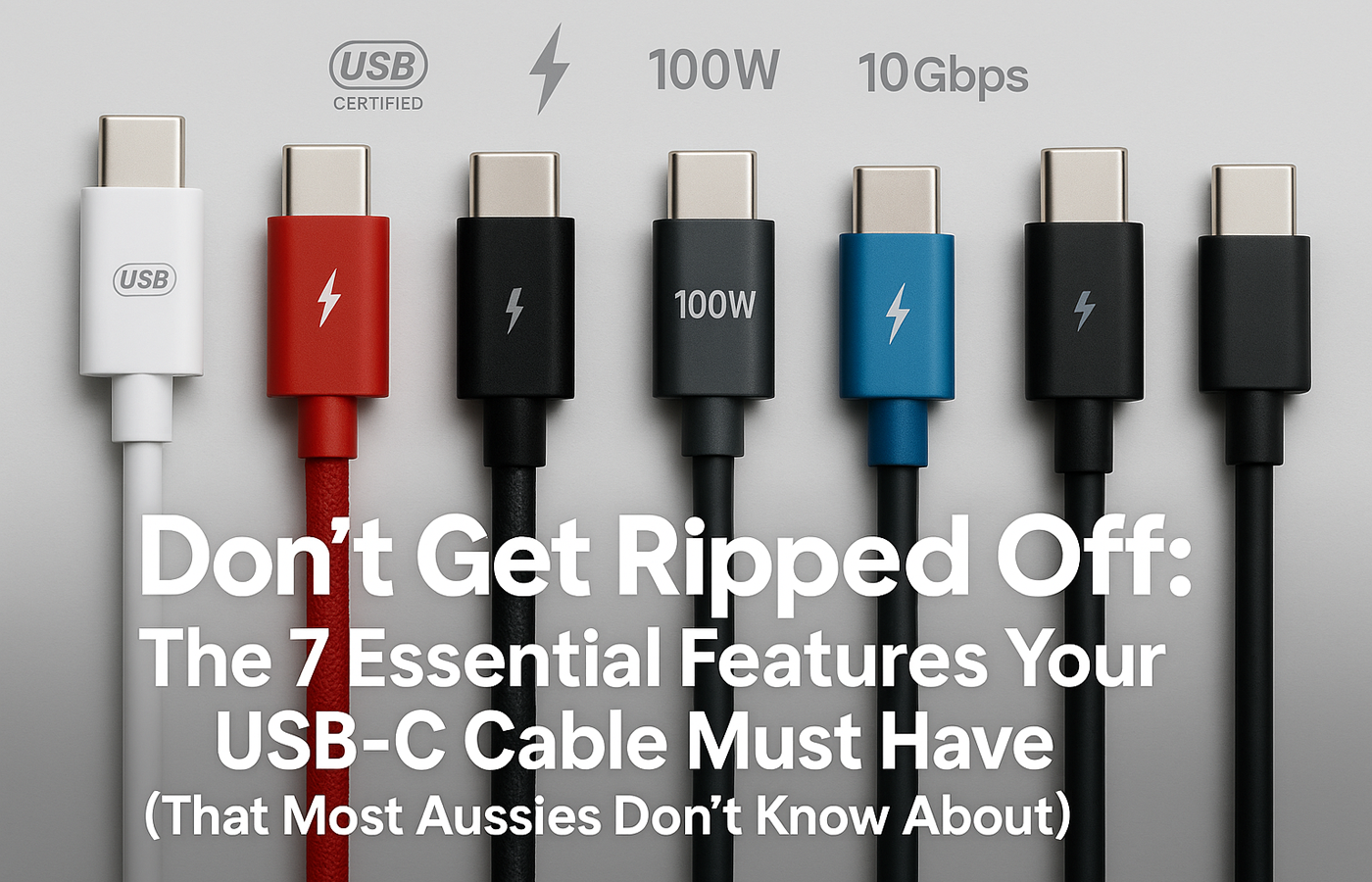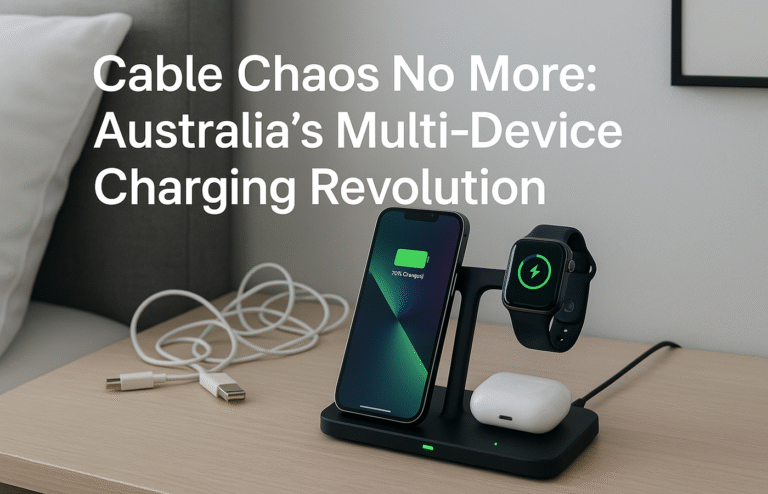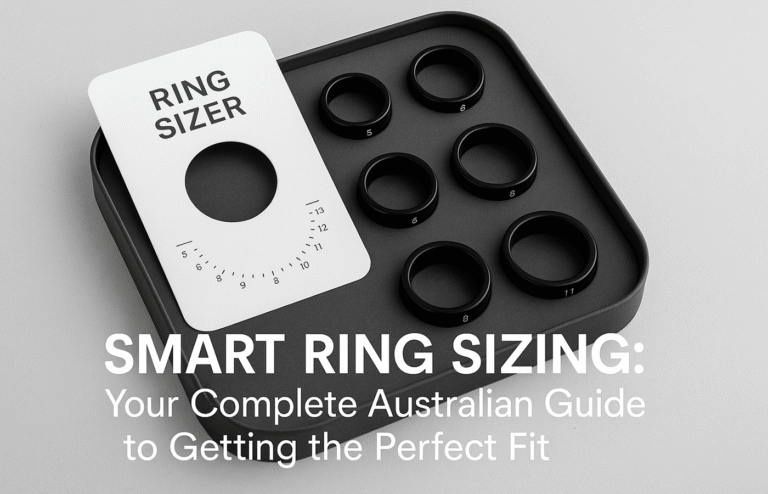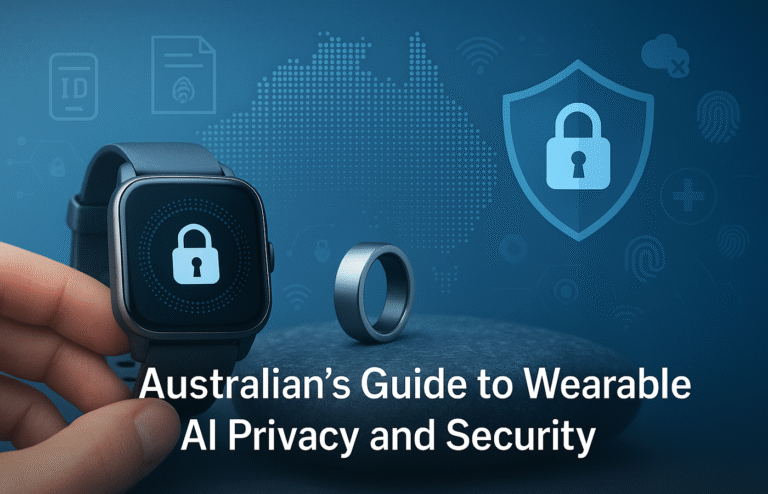Essential USB-C Cable Features: Australian Buying Guide for Safe Device Protection
USB-C cables range from $5-50 AUD, but seven critical specifications separate quality cables from dangerous knockoffs that could damage expensive devices.
Essential Features:
● Power Delivery certification with proper wattage ratings (20W-30W for phones, 60W+ for laptops)
● Australian RCM compliance and ACMA certification for safety and electromagnetic compatibility
● Data transfer specifications (USB 3.0 minimum for 5 Gbps speeds vs 480 Mbps USB 2.0)
● Quality construction with braided nylon exteriors and oxygen-free copper conductors
● Appropriate length considering voltage drop (shorter cables provide better power efficiency)
Advanced Features:
● E-marker chips for intelligent charging and Power Delivery 3.0 support (cables >60W)
● Australian Consumer Law warranty protection with local manufacturer presence
Recommendation: Sweet spot pricing between $20-35 AUD from reputable brands balances safety, performance, and device protection.
Don’t Get Ripped Off: The 7 Essential Features Your USB-C Cable Must Have (That Most Aussies Don’t Know About)
Walk into any electronics store across Australia and you’ll find USB-C cables ranging from $5 to $50, but here’s the shocking truth: most Australians are buying cables that could damage their expensive devices or simply don’t work as advertised. Whether you’re charging your new iPhone 16, syncing data from your fitness tracker, or powering your smartwatch, there are seven critical specifications that separate genuine quality cables from dangerous knockoffs – and it’s not just about the price tag.
From understanding why that cheap cable might fry your $500 Apple Watch, to knowing which safety certifications actually matter in Australia, this guide reveals the insider knowledge that electronics retailers don’t want you to know. We’ll decode the confusing world of power delivery ratings, data transfer speeds, and Australian compliance standards, giving you the confidence to choose cables that protect your devices, deliver reliable performance, and won’t leave you stranded with a dead phone when you need it most.
Why USB-C to USB-C is the Smart Choice for Australians
Before diving into the essential features, let’s address why USB-C to USB-C cables are increasingly becoming the preferred choice for Australian consumers. Unlike older USB-A to USB-C cables, USB-C to USB-C connections offer several distinct advantages that make them particularly valuable in our tech-heavy lifestyle.
Firstly, USB-C to USB-C cables support bidirectional power delivery, meaning you can charge devices in either direction. This is especially useful when you’re using a power bank to charge your phone, or when your laptop can charge your smartwatch. Additionally, these cables support the full USB-C specification, including higher power delivery rates and faster data transfer speeds that USB-A simply cannot match.
Moreover, as more Australian households adopt USB-C devices – from the latest iPhones to Android phones, tablets, laptops, and wearable devices – having USB-C to USB-C cables creates a unified charging ecosystem. This means fewer cables cluttering your desk, car, or travel bag, and greater compatibility across all your devices.
Feature 1: Power Delivery (PD) Rating – The Foundation of Safe Charging
The first and most crucial feature to look for is proper Power Delivery (PD) certification and rating. This isn’t just marketing jargon – it’s the difference between safely charging your devices and potentially causing permanent damage.
Genuine USB-C cables with PD support can handle anywhere from 15W to 100W of power delivery, but here’s where most Australians go wrong: they assume any cable marked “fast charging” will work properly. In reality, cheap cables often lack the proper internal wiring to handle higher wattages safely.
When shopping for a USB-C cable, look for specific PD ratings clearly marked on the packaging. For most smartphones and smartwatches, a 20W-30W rating is sufficient. However, if you’re planning to charge laptops or tablets, you’ll need cables rated for 60W or higher. Apple’s MacBook Pro, for instance, requires up to 96W for optimal charging speeds.
The consequences of using an under-rated cable extend beyond slow charging. Insufficient power delivery can cause your devices to heat up dangerously, potentially damaging the battery or internal components. In extreme cases, poorly made cables have been known to cause fires – a risk no Australian household should take.
Feature 2: Australian Safety Certifications (C-Tick/RCM and ACMA Compliance)
This is where many imported cables fail Australian consumers. Legitimate cables sold in Australia must comply with the Australian Communications and Media Authority (ACMA) regulations and display the Regulatory Compliance Mark (RCM). This isn’t optional – it’s a legal requirement that ensures the product meets Australian safety and electromagnetic compatibility standards.
When examining a USB-C cable, look for the RCM logo on the packaging or cable itself. This small marking indicates that the product has been tested and approved for use in Australia. Cables without this certification may not only perform poorly but could also interfere with other electronic devices or pose safety risks.
Furthermore, reputable manufacturers will provide documentation showing compliance with relevant Australian standards, including AS/NZS 62368.1 for audio/video equipment safety. While this might seem like bureaucratic paperwork, these certifications represent rigorous testing that cheap knockoffs simply don’t undergo.
The financial implications are significant too. If an uncertified cable damages your device, your warranty may be voided, and insurance claims could be rejected. Given that the average Australian smartphone costs over $800, and quality smartwatches can exceed $500, this protection is invaluable.
Feature 3: Data Transfer Speed Specifications
Not all USB-C cables are created equal when it comes to data transfer, and this is where the marketing becomes particularly misleading. Many cables advertise “USB-C” without specifying which USB standard they actually support.
For optimal performance, look for cables that explicitly state their data transfer capabilities. USB 2.0 cables (often the cheapest option) only support data speeds up to 480 Mbps. While this might be acceptable for basic charging, it’s frustratingly slow when transferring photos from your phone or syncing large files.
USB 3.0 and 3.1 cables offer significant improvements, with speeds of 5 Gbps and 10 Gbps respectively. For most Australian users, USB 3.0 provides an excellent balance of performance and cost. However, if you frequently transfer 4K videos or work with large datasets, investing in USB 3.1 or newer USB 3.2 cables (supporting up to 20 Gbps) makes financial sense.
The practical difference is substantial. Transferring a 1GB video file takes approximately 17 seconds with USB 3.0, compared to over 4 minutes with USB 2.0. When you’re trying to quickly backup photos before a flight or transfer work files, this time difference becomes crucial.
Feature 4: Build Quality and Materials – Beyond the Pretty Packaging
The physical construction of your USB-C cable directly impacts its longevity and safety. Premium cables use specific materials and construction techniques that dramatically extend their lifespan and improve reliability.
Look for cables with braided nylon or reinforced TPE (thermoplastic elastomer) exteriors. These materials resist tangling, withstand repeated flexing, and protect the internal wires from damage. The connectors should feel substantial and fit snugly into ports without being loose or overly tight.
Internal construction matters equally. Quality cables use oxygen-free copper conductors for optimal electrical performance and reduced resistance. The gauge (thickness) of these conductors affects both charging speed and safety – thicker conductors can handle higher currents more safely.
Pay attention to strain relief at both ends of the cable. This is the reinforced section where the cable meets the connector. Poor strain relief is the most common failure point for cheap cables, leading to exposed wires and potential safety hazards.
While you can’t see inside the cable, you can research the manufacturer’s reputation and read reviews from other Australian users. Brands like Anker, Belkin, and UGREEN have established track records for quality construction, while many no-name brands cut corners on materials to achieve low prices.
Feature 5: Length Considerations and Practical Applications
Cable length significantly impacts both performance and convenience, yet many Australians choose lengths based solely on immediate needs without considering long-term versatility.
For charging applications, shorter cables (0.5m to 1m) generally provide the most efficient power delivery and are ideal for desktop use or power banks. However, longer cables (1.5m to 2m) offer greater flexibility for bedside charging or when outlets are positioned inconveniently.
Here’s the crucial point most people miss: as cable length increases, voltage drop becomes more significant, particularly with cheaper cables using thinner conductors. A poorly made 3m cable might deliver significantly less power to your device than advertised, resulting in slower charging speeds.
For data transfer, cable length becomes even more critical. USB specifications include maximum recommended lengths for different standards. USB 3.0 cables shouldn’t exceed 3 metres for optimal performance, while USB 2.0 can stretch to 5 metres before signal degradation becomes noticeable.
Consider your specific use cases. If you primarily need the cable for charging your phone overnight, a 1.5m cable provides excellent versatility. For connecting devices to a TV or monitor, a 2m cable often provides the ideal balance of reach and performance.
Feature 6: E-Marker Chips and Advanced Features
This feature separates premium cables from basic ones, yet most Australian consumers have never heard of E-marker chips. These small electronic components are embedded in high-quality USB-C cables to enable advanced features and ensure safe operation at higher power levels.
E-marker chips communicate with connected devices to negotiate optimal charging parameters, prevent overloading, and enable features like Power Delivery 3.0. Cables rated for more than 60W are required to include E-marker chips under USB-C specifications.
The practical benefits are significant. E-marker enabled cables can dynamically adjust power delivery based on device requirements, potentially extending battery life and reducing heat generation. They also enable proper support for alternate modes, such as DisplayPort for video output or Thunderbolt 3 for high-speed data and video.
When shopping, look for cables that specifically mention E-marker support or “intelligent charging.” While these cables typically cost more (often $25-$40 AUD RRP compared to $10-$15 for basic cables), the enhanced safety and functionality justify the investment for users with multiple high-end devices.
Interestingly, you can identify E-marker cables by their slightly thicker connectors – the chip requires additional space within the connector housing. This physical difference is often the easiest way to verify that you’re purchasing a genuinely advanced cable.
Feature 7: Warranty and Australian Consumer Law Protection
The final essential feature isn’t technical – it’s legal protection under Australian Consumer Law. Reputable cable manufacturers offer warranties that comply with Australian consumer guarantees, providing recourse if the product fails to meet expectations.
Look for cables backed by at least a 12-month warranty from manufacturers with Australian presence or authorised local distributors. This ensures you can actually claim warranty service without shipping products internationally or dealing with foreign customer service.
Under Australian Consumer Law, products must be of acceptable quality and fit for purpose. This means a USB-C cable marketed for smartphone charging must actually charge smartphones safely and effectively. If it doesn’t, you’re entitled to repair, replacement, or refund regardless of the manufacturer’s warranty terms.
More importantly, choose cables from companies that maintain liability insurance and can compensate you if their product damages your devices. While this information isn’t always readily available, established brands typically carry appropriate insurance coverage, while unknown importers often don’t.
Keep your receipt and register products when possible. Many manufacturers offer extended warranties or enhanced support for registered products. Given that a quality USB-C cable should last several years with proper care, this documentation can prove valuable.
Making the Smart Purchase Decision
Armed with knowledge of these seven essential features, you can confidently navigate the confusing world of USB-C cables. Remember that the cheapest option rarely provides the best value when you factor in safety, reliability, and device protection.
For most Australian users, the sweet spot lies in cables priced between $20-$35 AUD RRP from reputable brands. These typically include proper PD ratings, Australian certifications, USB 3.0 data speeds, quality construction, and reasonable warranties.
However, don’t assume expensive automatically means better. Some cables are overpriced for their specifications, while others include features you may not need. Focus on the seven features outlined above rather than marketing claims or premium pricing.
Consider purchasing multiple cables for different purposes: a shorter, high-quality cable for desk use, a longer one for bedside charging, and a portable option for travel. This approach provides versatility while ensuring you always have a reliable cable available.
Finally, remember that USB-C cables are an investment in protecting devices worth hundreds or thousands of dollars. Spending an extra $15-$20 on a quality cable is insignificant compared to the cost of replacing a damaged smartphone, tablet, or laptop.
By prioritising these seven essential features, you’ll avoid the common pitfalls that trap many Australian consumers and ensure your USB-C cables provide safe, reliable performance for years to come.








